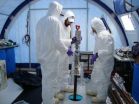(Press-News.org) CHICAGO – Exposure to traffic-related air pollution, particulate matter and nitrogen dioxide during pregnancy and during the first year of a child's life appears to be associated with an increased risk of autism, according to a report published Online First by Archives of General Psychiatry, a JAMA Network publication.
Autism is a diverse disorder with genetic and environmental factors likely contributing to its origins. Autism spectrum disorders are commonly characterized by problems in communication, social interaction and repetitive behaviors. Emerging evidence suggests the environment plays a role in autism, but only limited information is available about what exposures are relevant, their mechanisms of action, the stages in development in which they act and the development of effective of preventive measures, the authors write in the study background.
Heather E. Volk, Ph.D., M.P.H., of the University of Southern California, and colleagues examined the relationship between traffic-related air pollution, air quality and autism in a study that included data obtained from 279 children with autism and control group of 245 children with typical development who were enrolled in the Childhood Autism Risks from Genetics and the Environment study in California.
"Exposures to traffic-related air pollution, PM [particulate matter] and nitrogen dioxide were associated with an increased risk of autism. These effects were observed using measures of air pollution with variation on both local and regional levels, suggesting the need for further study to understand both individual pollutant contributions and the effects of pollutant mixtures on disease," the authors comment.
The authors used mothers' addresses to estimate exposure for each pregnancy trimester and for a child's first year of life. Traffic-related air pollution was estimated based on a model and regional air pollutant measures were based on the Environmental Protection Agency's Air Quality System data.
Children living in homes with the highest levels of modeled traffic-related air pollution were three times as likely to have autism compared with children living in homes with the lowest exposure. The higher levels of exposure to [particulate matter less than 2.5 and 10 µm in diameter] PM 2.5, PM 10 and nitrogen dioxide based on the EPA's regional air quality monitoring program were associated with an increased risk of autism.
"Research on the effects of exposure to pollutants and their interaction with susceptibility factors may lead to the identification of the biologic pathways that are activated in autism and to improved prevention and therapeutic strategies. Although additional research to replicate these findings is needed, the public health implications of these findings are large because air pollution exposure is common and may have lasting neurological effects," the authors conclude.
(Arch Gen Psychiatry. Published online November 26, 2012. doi:10.1001/jamapsychiatry.2013.266. Available pre-embargo to the media at http://media.jamanetwork.com.)
Editor's Note: This work was supported by grants from the National Institute of Environmental Health Sciences and by the MIND Institute's matching funds and pilot grant program. Please see the article for additional information, including other authors, author contributions and affiliations, financial disclosures, funding and support, etc.
Editorial: Dramatic Rise in Autism Prevalence Parallels Research Explosion
In an editorial, Geraldine Dawson, Ph.D., of the University of North Carolina at Chapel Hill, writes: "This issue of the journal features three articles on autism. A decade ago, the journal published about the same number of autism articles per year. This reflects a broad expansion in the number and diversity of research publications on autism spectrum disorder (ASD)."
"The upsurge of research parallels a dramatic increase in autism prevalence during the same period. In the past six years alone, the prevalence of ASD has increased 78 percent and the estimated annual cost of autism has more than tripled," Dawson continues.
"These articles point to an urgent need for more research on prenatal and early postnatal brain development in autism, with a focus on how genes and environmental risk factors combine to increase risk for ASD. Despite a substantial increase in autism research publications and funding during the past decade, we have not yet fully described the causes of ASD or developed effective medical treatments for it. More research is needed to develop strategies for preventing or reducing the disabling symptoms associated with this highly prevalent and costly neurodevelopmental disorder," Dawson concludes.
(Arch Gen Psychiatry. Published online November 26, 2012. doi:10.1001/jamapsychiatry.2013.488. Available pre-embargo to the media at http://media.jamanetwork.com.)
Editor's Note: Please see the article for additional information, including other authors, author contributions and affiliations, financial disclosures, funding and support, etc.
###
To contact Heather E. Volk, Ph.D., M.P.H., call Leslie Ridgeway at 323-442-2823 or email lridgewa@usc.edu. To contact editorial author Geraldine Dawson, Ph.D., call Thania Benios at 919-962-8596 or email thania_benios@unc.edu.
END
CHICAGO – A study of Medicare claims data suggests that eliminating payments for consultations commonly billed by specialists was associated with a net increase in spending on visits to both primary care physicians and specialists, according to a report published Online First by Archives of Internal Medicine, a JAMA Network publication.
Before 2010, Medicare payments for consultations were substantially higher than for office visits of similar complexity that were commonly billed by primary care physicians (PCPs). In January 2010, Medicare eliminated consultation payments ...
PASADENA, Calif., Nov. 26, 2012 — Patients newly prescribed a cholesterol-lowering medication were more likely to pick it up from the pharmacy if they received automated phone and mail reminders, according to a study published in the Archives of Internal Medicine today. This is one of a few published studies to examine strategies for reducing primary nonadherence, which occurs when patients do not pick up new prescriptions.
The study of 5,216 Kaiser Permanente Southern California patients found that those who received an automated reminder were 1.6 times more likely ...
The stems of shrubs have given researchers a window into a glacier's past, potentially allowing them to more accurately assess how they're set to change in the future.
Their findings have been published today, 27 November, in IOP Publishing's journal Environmental Research Letters, and show how a glacier's history of melting can be extended way past the instrumental record.
Much like the rings on a tree stump indicate how old it is, measuring the width of rings on the stem of a shrub can give a good indication of how well it has grown year on year. Under extreme environmental ...
CAMBRIDGE, MA -- A new imaging technique developed at MIT offers the first glimpse of the degeneration of two brain structures affected by Parkinson's disease.
The technique, which combines several types of magnetic resonance imaging (MRI), could allow doctors to better monitor patients' progression and track the effectiveness of potential new treatments, says Suzanne Corkin, MIT professor emerita of neuroscience and leader of the research team. The first author of the paper is David Ziegler, who received his PhD in brain and cognitive sciences from MIT in 2011.
The ...
For researchers who study Earth's past environment, disentangling the effects of climate change from those related to human activities is a major challenge, but now University of Massachusetts Amherst geoscientists have used a biomarker from human feces in a completely new way to establish the first human presence, the arrival of grazing animals and human population dynamics in a landscape.
Doctoral student Robert D'Anjou and his advisor Raymond Bradley, director of the Climate System Research Center at UMass Amherst, with UMass colleagues Nick Balascio and David Finkelstein, ...
NEW YORK (November 26, 2012)—Scientists have developed a system to predict the timing and severity of seasonal influenza outbreaks that could one day help health officials and the general public better prepare for them. The system adapts techniques used in modern weather prediction to turn real-time, Web-based estimates of influenza infection into local forecasts of seasonal flu.
Results appear online in the Proceedings of the National Academy of Sciences.
Year to year, and region to region, there is huge variability in the peak of flu season, which, in temperate areas ...
Several drugs companies have ineffectively tried to produce antibodies that bind to the IGF-1 receptor on the cell surface, which has a critical part to play in the development of cancer. Scientists at Karolinska Institutet in Sweden have now ascertained how these antibodies work, and can explain why only some cancer patients are helped by IGF-1 blockers during clinical tests. The researchers also present a means by which drugs of this kind could help more cancer patients.
Every cell contains thousands of tiny receptors that help it communicate with other cells. These ...
RENO – This week a pioneering study published in the Proceedings of the National Academy of Sciences (PNAS) and co-authored by Dr. Alison Murray and Dr. Christian Fritsen of Nevada's Desert Research Institute (DRI) reveals, for the first time, a viable community of bacteria that survives and ekes out a living in a dark, salty and subfreezing environment beneath nearly 20 meters of ice in one of Antarctica's most isolated lakes.
Lake Vida, the largest of several unique lakes found in the McMurdo Dry Valleys, contains no oxygen, is mostly frozen and possesses the highest ...
SALT LAKE CITY— Discovery of a new drug with high potential to treat Ewing sarcoma, an often deadly cancer of children and young adults, and the previously unknown mechanism behind it, come hand-in-hand in a new study by researchers from Huntsman Cancer Institute (HCI) at the University of Utah. The report appears in today's online issue of the journal Oncogene.
"Ewing sarcoma is almost always caused by a cancer-causing protein called EWS/FLI," said Stephen Lessnick, M.D., Ph.D., director of HCI's Center for Children's Cancer Research, professor in the Department of ...
Biologists at UC San Diego have demonstrated for the first time that marine algae can be just as capable as fresh water algae in producing biofuels.
The scientists genetically engineered marine algae to produce five different kinds of industrially important enzymes and say the same process they used could be employed to enhance the yield of petroleum-like compounds from these salt water algae. Their achievement is detailed in a paper published online in the current issue of the scientific journal Algal Research.
The ability to genetically transform marine algae into ...

